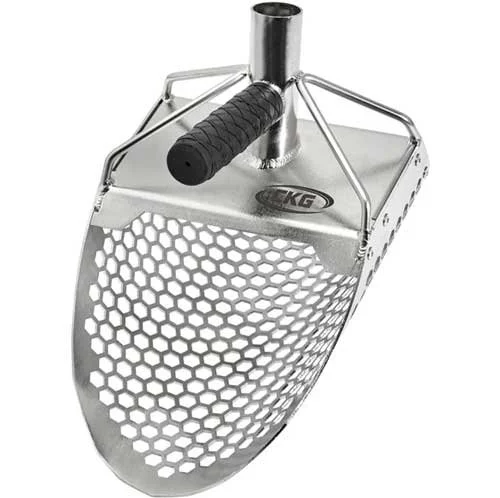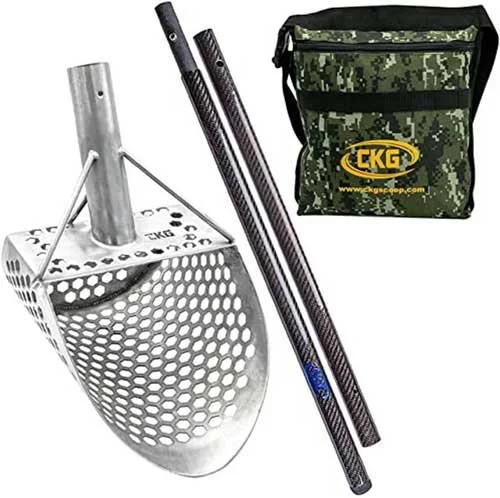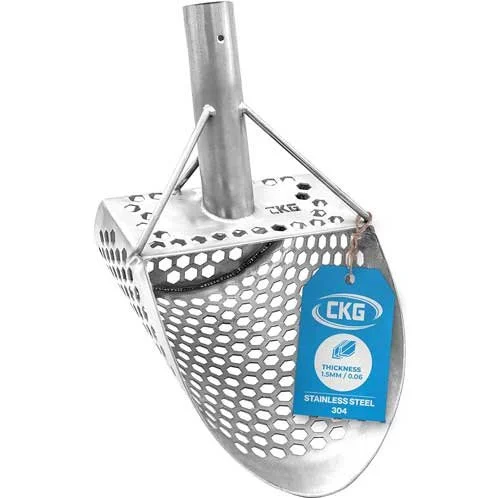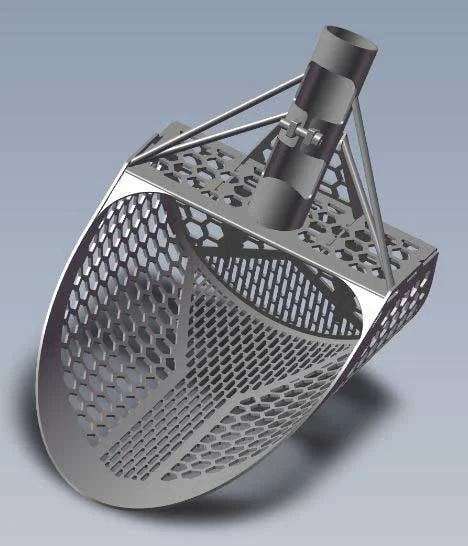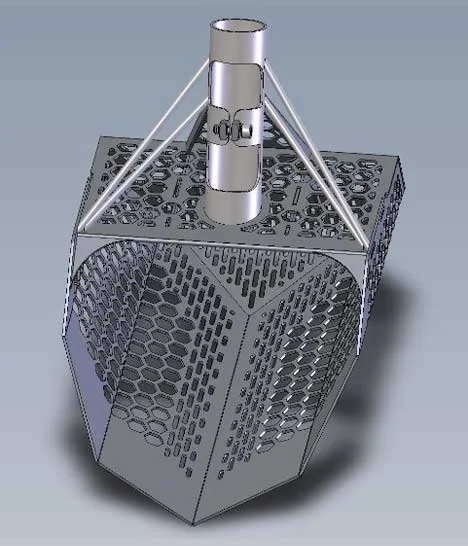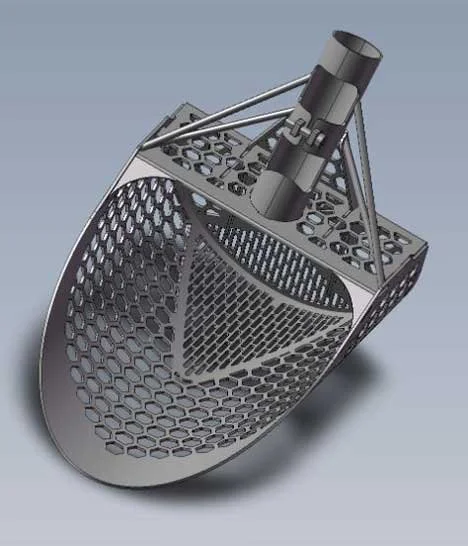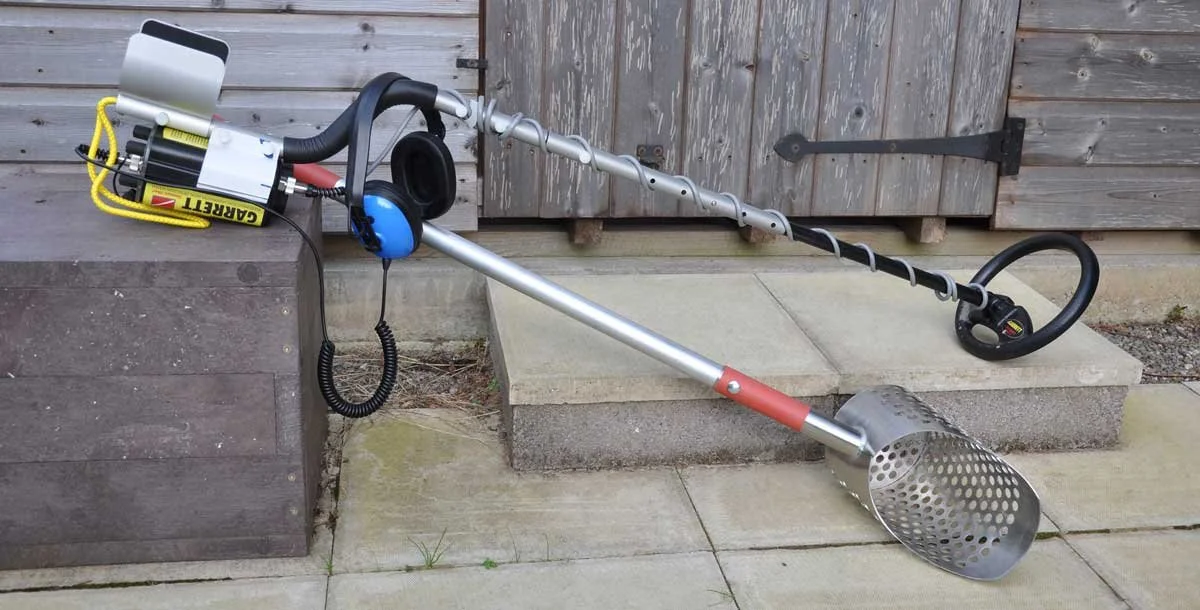Best Sand Scoop for Metal Detecting
Unearthing the Ideal Sand Scoop for Your Metal Detecting Adventures
Embarking on a treasure hunt along the shore or within the embrace of the sea? Your success hinges not just on your metal detector but also on the scoop in your hand.
This article delves into the essentials of choosing a scoop that's both a faithful companion and an efficient tool, guiding you through materials, designs, and ergonomics tailored for the hobbyist and the serious hunter alike.
Disclaimer: This blog post contains affiliate links. If you make a purchase through one of these links, I may receive a small commission at no additional cost to you. This helps support my work and allows me to continue providing valuable content. Thank you for your support!
Best Value Sand Scoops
Sand scoops from CKG offer the best bang for your buck.
In business in Florida, USA since 2005, CKG strives to provide the highest quality scoops at reasonable prices.
They have three renditions on their sand scoop design:
With hand hold
With long handle
Just the scoop
All models feature 304 stainless steel construction and improved welds over their older models for increased strength and durability.
Sizes small scoops have hexagonal holes with diameters of 7mm.
Medium and large sized scoops have hexagonal holes with diameters of 10mm.
As an Amazon Associate, I earn from qualifying purchases.
CKG Hand Scoop
• Rubber handle for comfortable, firm grip
• 304 stainless steel construction
• Can attach your own, longer handle to base
#CommissionsEarned
CKG Stand Scoop
• 45” carbon fiber handle included
• 304 stainless steel scoop
• 4 sizes available
#CommissionsEarned
CKG Scoop
• Best results with your own handle installed
• 1.2” diameter hole for handle
• Available in Titanium for ultralight performance
#CommissionsEarned
Best Overall Sand Scoops
Xtreme Scoops, owned by John Volek, a forensic metal detecting expert and instructor, makes the highest quality sand scoops for metal detecting in the world.
Made in the USA from 316 Marine Grade Stainless Steel or Titanium with Carbon Fiber Handles and backed by a 10 Year Warranty.
They’re not cheap, but they’ll likely be the last scoops you ever buy.
If you’re dedicated to metal detecting and are looking for the best scoop out there, look no further.
Sand Shredder
Surf Master
Titanium Sand Shredder
Buyer’s Guide
Embarking on a metal detecting adventure on the beach requires not just enthusiasm but the right gear, especially when it comes to finding those hidden treasures buried in the sand.
A crucial tool in any detectorist's arsenal is the sand scoop, and choosing the right one can significantly enhance your search efficiency.
Here’s everything you need to know to select the best sand scoop for your metal detecting ventures.
Understanding Sand Scoop Materials
Stainless Steel
Pros: Durable and resistant to corrosion, making it ideal for frequent use in salty beach environments.
Cons: Heavier, which might contribute to fatigue over extended periods of use.
Titanium
Pros: Offers a great balance between lightweight design and strength. Superior corrosion resistance and mechanical stability to stainless steel.
Cons: Higher cost but beneficial for those looking for the best.
-
When selecting a sand scoop for metal detecting, material choice is crucial for balancing durability, weight, and corrosion resistance.
Stainless Steel (304) is popular for its robustness and resistance to rust, suitable for less aggressive environments.
Stainless Steel (316), enriched with molybdenum, offers enhanced corrosion resistance against saline or chloride exposure, ideal for saltwater beach detecting.
Aluminum scoops are lightweight, making them easier to handle during long searches but may not withstand rough conditions as well as stainless steel.
Titanium offers the best strength-to-weight ratio and exceptional durability but at a higher cost.
Consider your typical detecting environment and balance between durability, weight, and budget to choose the ideal material for your sand scoop.
Handle Types and Comfort
A good handle is just as important as the scoop's material. Comfortable grip and length suited to your height can prevent strain and make detecting more enjoyable.
Fixed vs. Adjustable
Fixed Handles are sturdy but lack flexibility.
Adjustable Handles offer customization for different users or detecting conditions but check for robust locking mechanisms to avoid wobbliness.
Material Choices
Fiberglass handles are lightweight and relatively durable, a middle-ground option.
Metal Handles provide strength but add weight. Innovative materials like specially designed PVC can offer durability with less weight.
-
The Essence of Handle Types
Straight Handles
Definition and Use: Straight handles are the quintessential choice for many enthusiasts, offering a straightforward, no-frills approach to metal detecting. Ideal for beaches and soft terrains, these handles provide a direct and robust grip, facilitating easy penetration into the sand.
Comfort and Ergonomics: While offering simplicity, straight handles may not always deliver the best in terms of ergonomic comfort, especially during prolonged use. For some, the lack of curvature can lead to strain on the wrists and forearms.
Curved Handles
Definition and Use: Curved handles are designed with ergonomics in mind, following the natural arc of your grip. This design is particularly beneficial for those who spend long hours metal detecting, as it can significantly reduce the strain on your hands and wrists.
Comfort and Ergonomics: The curvature allows for a more relaxed grip, which can minimize fatigue. This type of handle is especially recommended for individuals with previous wrist or hand discomfort.
Adjustable Handles
Definition and Use: Adjustable handles cater to a wide range of heights and personal preferences, allowing for a customized metal detecting experience. They can be extended or shortened according to the user's comfort, making them versatile for various terrains and user heights.
Comfort and Ergonomics: These handles offer the utmost in personalization. However, the mechanism for adjustment can sometimes introduce weak points in the structure, potentially affecting durability. It's crucial to seek out models known for their robust construction.
Material Matters
Fiberglass: Offers a lightweight option with considerable durability. It's resistant to corrosion, making it suitable for beach hunting but can feel stiff to some users.
Carbon Fiber: The premium choice for those seeking the best in lightweight and strength. Carbon fiber handles provide an excellent balance between durability and ease of use but come at a higher cost.
Aluminum: A widely used material due to its balance of weight and strength. Aluminum handles are moderately lightweight and durable, although they can become uncomfortable in extreme temperatures.
Comfort Enhancements
Grip Material
The material of the grip can significantly affect comfort. Foam or rubber grips provide additional cushioning, reducing the impact on your hands and improving the overall feel during extended use.
Grip Design
Textured or ribbed grips can offer better hand traction, preventing slippage caused by sweat or water. This feature is particularly beneficial in wet conditions or when wearing gloves.
Size and Hole Pattern
Larger scoops cover more area but can be overkill for casual hobbyists or those with smaller finds. Hole size and pattern affect sifting; smaller holes better retain tiny objects but require more shaking, which can be tiring.
-
The Significance of Size
The size of a sand scoop directly correlates with the scope of your search and the physical effort required.
Choosing the right size is a delicate balance between the area you wish to cover and the weight you are comfortable handling.
Compact Scoops
Ideal For: Enthusiasts who prioritize agility and those who frequently travel to their metal detecting locations.
Compact scoops are perfect for children and individuals looking for a lightweight option that's easy to maneuver in tight spaces.
Considerations: While their portability is unmatched, compact scoops may require more scoops to sift through the same amount of sand as their larger counterparts, potentially slowing down your search.
Standard Scoops
Ideal For: The majority of hobbyists. These scoops offer a harmonious balance between size and functionality, making them suitable for a variety of conditions, from dry sand to shallow waters.
Considerations: Standard scoops are designed to be the jack-of-all-trades, but for specialized conditions (like deep water hunting), they might not be the most efficient choice.
Large Scoops
Ideal For: Dedicated hunters targeting expansive beaches or those in pursuit of deep treasures.
Their larger size allows for covering more ground with each scoop and is ideal for digging deeper.
Considerations: The increased size and capacity come with added weight, which can lead to quicker fatigue.
Ensure you have the physical stamina to wield a larger scoop comfortably for extended periods.
Hole Pattern Dynamics
The pattern and size of the holes in a sand scoop play a pivotal role in filtering out unwanted debris while securing your finds.
This feature is crucial in determining the efficiency of your treasure retrieval.
Small Holes
Ideal For: Capturing tiny artifacts or fine jewelry. Small holes ensure that even the most diminutive treasures don't slip through the cracks.
Considerations: The finer mesh-like pattern can become clogged with wet sand or mud, requiring more effort to sift through, which might slow down the search process in certain environments.
Large Holes
Ideal For: Quick sifting in areas with larger debris. Large holes allow for rapid sand evacuation, making them excellent for areas with shells and stones.
Considerations: While they expedite the sifting process, larger holes may allow smaller treasures to escape, potentially overlooking valuable finds.
Hexagonal vs. Round Holes
Hexagonal Holes: Offer a unique compromise between speed and retention, providing an efficient sifting experience while minimizing the loss of smaller targets.
Round Holes: The traditional choice, known for their durability and straightforward design. They are particularly effective in sandy conditions where quick drainage is key.
Maintenance Tips
Regular care extends your scoop's lifespan. Rinse after each use, especially if used in salt water, and apply protective sprays like WD-40 to prevent rust and corrosion.
-
Regular Cleaning
After Each Use: Rinse your sand scoop with fresh water, especially if it has been used in saltwater environments.
Salt can accelerate corrosion, even on stainless steel or other corrosion-resistant materials. A thorough rinse will remove salt and other minerals.
Deep Cleaning: Occasionally, a more thorough cleaning might be necessary, especially if the scoop is used in muddy or highly mineralized soils.
Use a soft brush and mild soap to gently scrub any stubborn dirt or grime. Rinse thoroughly.
Check for Wear and Tear
Inspect Regularly: Before and after each use, inspect your sand scoop for signs of wear, including cracks, bends, or holes that have become enlarged or misshapen.
Early detection of wear can prevent failure during use.
Handle Care: Pay particular attention to the handle, as it often bears the brunt of the force used in digging.
Ensure that any adjustable or fixed components are tight and in good condition.
Rust Prevention and Treatment
Preventive Coatings: If your sand scoop is made from a material prone to rust, consider applying a protective coating.
Silicone-based sprays or marine-grade protective oils can provide a thin barrier against moisture.
Rust Treatment: Should rust appear, address it promptly to prevent further corrosion.
Use a wire brush or sandpaper to remove surface rust, then apply a rust inhibitor or paint designed for metal surfaces to the affected area.
Storage and Transportation
Dry Storage: Always store your sand scoop in a dry, ventilated area. Humidity can lead to rust and corrosion over time.
If possible, hang the scoop rather than laying it on a flat surface, to allow air circulation.
Transportation Protection: When transporting your scoop, especially with other metal detecting equipment, protect it from scratches and impacts.
Use a scoop cover or wrap it in a soft material. Avoid leaving it exposed to sunlight for prolonged periods, as UV can degrade handles made from plastic or rubber.
Seasonal Maintenance
Off-Season Care: If you have an off-season for metal detecting, this is an excellent time for a thorough maintenance check.
Deep clean the scoop, inspect for any wear, and apply protective coatings as needed. Store it properly to prevent any damage during its rest period.
Lubrication: For scoops with moving parts or adjustable handles, periodic lubrication can prevent seizing and wear.
Use a corrosion-resistant lubricant, applying it sparingly to joints and moving parts.
Conclusion
Selecting the right sand scoop is as crucial as choosing your metal detector.
The perfect scoop enhances your detecting expeditions, marrying functionality with ease of use.
Whether you're navigating the soft embrace of sandy beaches or the challenging terrains of rocky shores, our guide arms you with the knowledge to pick a scoop that's your treasure-hunting ally, ensuring every outing is rewarding.
Thanks for reading.
Share this post to help the website grow ☺


